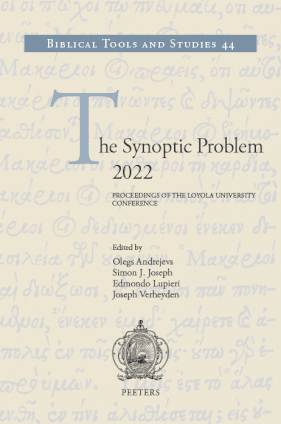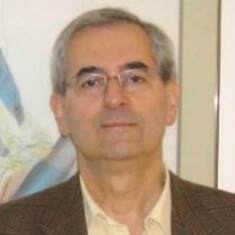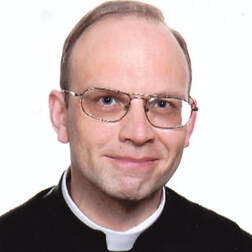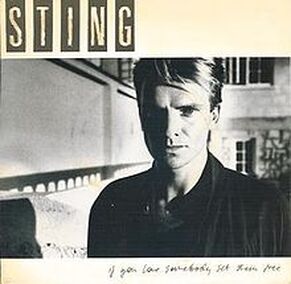| Alan Garrow Didache |
the problem page
 The Synoptic Problem 2022: Proceedings of the Loyola University Conference, eds Olegs Andrejevs, Simon J. Joseph, Edmondo Lupieri and Joseph Verheyden (BiTS 44, Leuven: Peeters, 2023) includes seven contributions by six MPHers including: Ron Huggins, Chakrita Saulina, Rob MacEwen, Edmondo Lupieri and Jeff Tripp. My contribution, ''Frame and Fill' and Matthew's use of Luke', 227-298, is available Open Access. This chapter looks at how Plutarch, Josephus, Tatian, Ammonius of Alexandria and Eusebius combined (or aligned) multiple versions of the same narrative. It concludes that Matthew using Luke runs with the grain of that practice, while Luke using Matthew does the opposite.
1 Comment
 Rob MacEwen's Matthean Posteriority: was published on the 29th January 2015 - the same day (and in the same series) as John Poirier and Jeffery Peterson's edited volume Marcan Priority without Q. The MPH received no attention in the latter volume other than in the Introduction. Here it is noted in passing that the term 'Marcan Priorty without Q' might also apply to the theory espoused by Ron Huggins, Martin Hengel, and others. Fast-forward six years to 11th May 2023 and the publication of Olegs Andrejevs, Simon J. Joseph, Edmondo Lupieri and Joseph Verheyden (eds). The Synoptic Problem 2022: Proceedings of the Loyola University Conference (Leuven, Peeters, 2003). Here the editors' Introduction includes the MPH at a very different level: In hindsight, it now seems clear that the emergence of the MPH will be cited as one of, if not the defining feature of the 2010s as far as the synoptic studies are concerned. … With the highest number of pro- and MPH-leaning contributions published by various authors in one place to date (Garrow, Huggins, Lupieri, MacEwen, Saulina, Tripp), this volume will likely be remembered as the moment the MPH crossed into the mainstream of synoptic studies. Thereby its theorists have made good on the momentum the MPH somewhat unexpectedly generated in the 2010s. Several factors have contributed to this transformation, critically important of course has been the publication of Rob MacEwen's book. Also high on that list, however, must come the contribution of Olegs Andrejevs (pictured). While also a staunch supporter of the Two Document Hypothesis, Olegs has created space for MPH-inclusive debate at SBL as well as in the Loyola Conference volume. Thank you Olegs for your part in increasing the MPH.
The Matthean Posteriority Hypothesis (MPH) has begun to attract critical attention. After an earlier response by Gerald Downing in 2017, 2022 saw the publication of two essays that specifically challenge the idea that Matthew used Luke. My response, 'Gnats, Camels and Matthew's use of Luke', JSNT (2023), asks which of these criticisms is most telling.
To celebrate the fifth anniversary of the $1,000 Challenge to Bart Ehrman (in December 2017) here is the story of a student who was considering similar questions at roughly the same time.  Hendry Ongkowidjojo is a senior pastor at G.K.A. Elyon, Surabaya, and a New Testament lecturer at STT Reformed-Injili International, Jakarta. He first became interested in the possibility of Matthew using Mark and Luke, while working on a proposal for his dissertation at Trinity Theological College, Singapore (completed in 2017). Here is his story: “Before applying to the doctoral program, the area of New Testament that I studied was Paul. My thesis at Trinity Evangelical Divinity School, Illinois, deals with the History of the Interpretation of Romans 9. In fact, initially I planned to do a dissertation on Paul use of Isaiah. Everything changed when I read John Kloppenborg's, Excavating Q. I became interested in the Synoptic Problem for the very first time. Previously, Robert Stein's The Synoptic Problem had convinced me that Q was the best explanation to the Synoptic Problem. Since then I had never questioned Q, and had even promoted Q to the students I teach. But after I read Kloppenborg, who is actually one of the main proponents of Q, it dawned on me that things weren't that simple. My interest in these issues was strengthened by dozens of years of experience serving in Indonesia. As a servant of God living in the largest Muslim country in the world, I often receive questions about Christ and his history. And the differences found in the Synoptic Gospels are often used as ammunition to question Christianity. Kloppenborg's book therefore made me want to understand more about the relationship between the Synoptic Gospels. As I prepared my research proposal I became aware that the possibility of Matthew using Mark and Luke was barely mentioned in the literature. I read a lot about Q, Farrer, Griesbach, and even other much more complicated theories, but very rarely did anyone even mention, let alone propose, that Matthew might have used Mark and Luke. As a novice, I wondered if this was because the experts all knew a reason why Matthew could not have used Mark and Luke that was so obvious that no further discussion as needed. But then I discovered that, towards the end of his career, Martin Hengel proposed that Matthew used Luke. This was interesting to me. On the one hand, if Hengel supported this theory, why was it not more popular? On the other, surely Hengel would not have gone against the grain without good reason. Furthermore, given the impasse in the debate between Q and Farrer supporters, it seemed sensible to study the only "simple" possibility that had been overlooked - the idea that Matthew used Mark and Luke. The more I study, the more I see the explanatory power of the Matthean Posteriority Hypothesis (MPH). I find that it is particularly helpful in understanding and applying Matthew's Gospel, both academically and pastorally. More recently, I was overjoyed to discover that there are now many more New Testament scholars who hold the MPH. I do believe that reading Matthew's Gospel with the perspective that Matthew knows Luke and Mark is very promising in both solving the Synoptic Problem and in helping us to understand and apply Matthew's Gospel.” A video version of Ron's SBL paper: 'Luke's Chronic-Fatigue Syndrome or Matthew's Quest for Order and Universal Applicability' is now available.
 Chakrita Saulina, a native of Jakarta, Indonesia, is Assistant Professor of Biblical Studies (New Testament) at Seattle Pacific University. She holds degrees from the University of Indonesia (B.Eng, 2006); Acadia Divinity College (M.Div, 2013); Yale University (S.T.M., 2016) and the University of Cambridge (PhD, 2021). Her doctoral dissertation, supervised by Prof Judith Lieu, was entitled: “The Narrative Function(s) of Evil Spirits in the Gospel of Luke”. Chakrita is a member of the steering group for “The Interrelations of the Gospels Consultation” at SBL, and will be presenting a paper in this section in Denver on Sunday 20th November, 2022. Here she describes the steps that caused her to suspect that Matthew used Luke: “I first encountered the Synoptic Problem about 11 years ago when, in my first New Testament class, Craig Evans explained Markan Priority and the concept of Q. For many years I never questioned what I’d been taught. Then I started teaching and working on my PhD. In my doctoral studies I examined the narrative function(s) of evil spirits in Luke. I was drawn to this topic because Luke highlights these malevolent characters more than any other gospel and I wanted to find out why. While studying the relevant stories as individual units and within the broad sweep of the gospel, I considered Luke’s distinctive voice when compared with parallel episodes in Mark and Matthew. This caused me to appreciate for the first time how closely Matthew and Luke agree at certain points in the Double Tradition. Particularly, I was drawn by the verbatim agreements in the Temptations and Beelzebul Controversy. In the latter, the word-for-word parallels are particularly striking in the two accounts of the return of the evil spirit (Luke 11:24-26//Matt 12:42-45). Besides these similarities, the differences between Luke and the other two Synoptics are also apparent, particularly in the travel narrative. There is a huge spectrum between the similarities and differences in terms of order and wording of the synoptics: they can be very similar, and they can also be very different. It means that each evangelist has some degree of freedom both at the micro-level (the wording used for a particular part) or macro-level (order of passages with the whole) in departing from or following their sources. Given this freedom, if Luke and Matthew independently used Q, it is hugely coincidental that they both wrote virtually identical passages in similar contexts. This coincidence is even more extraordinary if we consider that Luke and Matthew may have had two or more sources. How then did they come to the same decision in writing a very similar passage in a very similar context independently? As Mark Goodacre puts it, this is surely, ‘Too Good to be Q’. I remember my own experience as a teacher several years ago, when I noticed that two students had very similar answers to the same question. I was certain that one was influenced by the other, which was indeed the case. I wondered at that moment: besides having Mark as one of their primary sources, could it be that Luke “plagiarized” Matthew or vice versa? I also recalled that Luke’s Double Tradition was closer to Q. So, was it really necessary for Q to be a separate tradition independently consulted by Luke and Matthew? Why couldn’t Luke have influenced Matthew or vice versa? Could it be that the “Q” used by Matthew was actually Luke? While looking for Luke’s distinct voice, his overall plot and the role of evil spirits in it, I came across other reasons to suspect that Luke may have been one of Matthew’s sources. Given Luke’s generally extensive use of synonyms, his range of names for evil spirits is surprisingly limited. This is particularly surprising if Luke used Matthew since Matthew has a relatively rich list of names denoting Satan. In many ways, Luke is much more similar to Mark in this naming issue, which may also signify an older tradition than what we find in Matthew. Worth noting, for instance, Mark only uses Σατανᾶς in describing the archenemy of God throughout his gospel. The use of this term might not appear surprising unless we consider how it comes to be the most common name for the chief of demons in the New Testament. Luke’s use of the terms σατανᾶς and διάβολος convey a new development of the meaning of these two terms in the Jewish tradition, which refers to the archenemy of God. In “Luke’s Naming of Evil Spirits and The Three Layers of Interpretation”, a paper presented at SBL 2019, I argued: 1) The use of either διάβολος or σατανᾶς in each scene where they appear in Luke is intentional and not merely for the sake of literary variety; and 2) The historical Jesus may have been the reason for σατανᾶς, an adaptation of aramaic term סָטָנָא, becoming the most popular term referring to the chief of demons. In the second temple period, the term ‘satan’ is not the most popular word used to denote the leader of demons. In the Dead Sea Scrolls, we find ‘Mastema’ (18 times) and ‘Belial’ (88 times) appear more frequently than ‘Satan’. Several other references to the ruler of the demons in the second-temple apocalyptic texts include Semyaz and Azazel as chiefs of the fallen angels in 1 Enoch 9; Sammael (1:8, 11:2:1), Beliar (1:8f; 2:4; 3:11), and Satan (2:2,7; 5:16) in the Martyrdom and Ascension of Isaiah. Contrary to this ‘reservoir’ of names for the leaders in the demonic world, it is striking that in Luke and the NT in general, an unpopular term like σατανᾶς gains popularity. The historical Jesus may have used this term and it became common within his circles of disciples. This is also supported by Foerster who argues, “Study[sic] of the Synopt. and Ac. suggest that Σατανᾶς is closer to Palestinian usage…” Hence, in my PhD dissertation I claim that Luke’s use of Σατανᾶς may represent an earlier tradition (which may include Markan influence) that Luke follows closely. Luke uses σατανᾶς five times in his gospel: 10:18, 11:18, 13:16, 22:3, 31, and noticeably most of these are unique (except 11:18). Moreover, in this gospel, σατανᾶς appears almost exclusively in Jesus’s speech (10:18, 11:18, 13:16, 22:31, except, 22:3). A similar pattern can also be found in Mark (except, 4:15) and Matthew. Also, Breytenbach and P.L. Day (in Dictionary of Deities and Demons in the Bible (DDD)) argue that prior and contemporary to the gospel, there is no datum of σατανᾶς among Greek writings associated with non-Jewish or non-Christian writers. The meaning of the root word śāṭān itself can only be developed from its occurrences in the Hebrew Bible, since there is no other occurrence of this term prior or contemporary to the Scripture. However, Luke’s use of διάβολος comes from his adaptation of the Septuagint. This term may have been used because it was more familiar to the readers; the word διάβολος is found in both Hellenistic and Jewish literature. Among Greek texts that were written between the 4th century BCE and the1st century CE, διάβολος appears significantly more often than σατανᾶς. If Luke had access to Matthew, Matthew’s effect on Luke’s vocabulary seems to be very minimal. In the temptation of Jesus (in which the two evangelists present many close parallels), Luke employs the term διάβολος four times. Luke could have changed one of these to another term such as σατανᾶς or ὁ ἐχθρός (which he uses in 10:10), similar to what we can observe in Matthew’s version of the temptation where Matthew refers to Satan once as ὁ πειράζων (4:3). Luke, however, applies an unvarying title throughout the passage. The absence of ὁ πειράζων and ὁ πονηρός in Luke is striking if he had access to Matthew since these titles fit well with Luke’s theological agenda. Luke underlines the role of the Devil as the tempter in at least in three places: Jesus’s temptation scene, the parable of the sower, and Jesus’s passion. It seems more probable, therefore, that it is Matthew who has developed Luke’s limited vocabulary, rather than the reverse. There are two other issues that also lead me to suspect Luke’s influence over Matthew. First, Luke’s central section (the travel narrative) has many parallels to Matthew’s Sermon on the Mount. Many Lukan scholars would agree that the travel narrative is the crux in Luke’s Gospel; many have pondered how Luke may have ordered his material in this section. If Luke had access to Matthew, the way Luke dispersed or scattered many passages in Matthew’s Sermon on the Mount is difficult to explain and runs against the grain of ancient compositional practices. However, if Matthew had access to Luke, the former may have decided to gather Luke’s “scattered” material, much as other ancient authors coordinated parallel sources to create a more comprehensive whole. Second, examining Luke’s plot, I observed how Isaiah has an important role in Luke’s Promise-Fulfillment framework. Luke highlights how Jesus’s life and ministry fulfills Isaiah’s exodus motif (often known as Isaiah’s new exodus). If Luke had access to Matthew, it is surprising how Luke reduces the space that Isaiah gains in Matthew’s Gospel. Luke only incorporates a small number of direct citations from Isaiah (fewer than Matthew). Even more surprising is the omissions of some direct mentions of Isaiah’s name; Matthew mentions Isaiah’s name in: 3:3, 4:14, 8:17, 12:17, 13:14: 15:7. It makes more sense to suppose that Matthew’s adaptation of Isaiah was influenced by Luke, rather than the other way around. At one point in my dissertation research, I took a bit of a “detour” into the Synoptic Problem. Reading Mark Goodacre (who thinks Luke used Matthew) and Rob MacEwen (who thinks Matthew used Luke) I certainly agreed more with Rob. At some point during my time in Cambridge, I also got the chance to talk with Richard Bauckham. I forget how the conversation started, but I remember vividly that he also supports the idea that Matthew used Luke rather than the other way around. During that period, I also heard Alan Garrow’s presentation ‘Why not Matthew’s use of Luke?’ at the Graduate Seminar. Alan’s presentation of the macrostructure of Matthew’s indebtedness to Luke was really persuasive. Each of these factors has contributed to my growing interest in the case for Matthew’s use of Luke. I look forward to participating in this rapidly developing debate." Chakrita will be presenting at SBL Denver, 2022 Session 20-128: November 20th 9.00-11.30am. “Competitive Traditions: Luke’s and Matthew’s (Con)textualization of the Beelzebul Controversy”. An expanded version of this paper is also due for publication in: The Synoptic Problem 2022: Proceedings of the Loyola University Conference, O. Andrejevs, Simon J. Joseph, Edmondo Lupieri, Joseph Verheyden (eds.) (Leuven: Peeters, forthcoming) More MPH Origin Stories  Prof Edmondo Lupieri holds the John Cardinal Cody Endowed Chair in New Testament and Early Christianity at Loyola University Chicago. An early advocate of Matthew's use of Luke, Edmondo first published on this subject, in Italian, in 1988.[see below] He is editor, alongside Olegs Andrejevs, Simon J. Joseph and Joseph Verheyden, of the forthcoming: The Synoptic Problem 2022: Proceedings of the Loyola University Conference (BiTS 44: Leuven: Peeters) and author of the forthcoming: “’Q o non Q, questo è il dilemma’. Riflessioni sulle avventure di un’ipotesi,” in Auctores Nostri 25 (2022). Here he recalls how he first came to reject the tradition conception of Q: "Why not Q? I remember vividly. I was at the University of Turin, Italy, working first as Assistant and then as Associate Professor of “Christian Origins”. It was the mid-Eighties. And, when I was offering courses centered on the Gospels, as I had been taught, I regularly explained the Synoptic Problem with the usual recourse to the Two Sources Hypothesis. Yes, we all knew it, there is no manuscript of Q, but the reconstruction is quite sure and then there is the Gospel of Thomas that proves that there were Gospels that contained almost only logia of Jesus and no Passion narrative. I remember writing with chalks on the blackboard for my students (no computers nor e-mails in those years) various parallel passages of Matthew and Luke, in columns, with arrows and lines to connect the contents… My background was in Classical Philology: Greek Literature at the University of Pisa and at the Scuola Normale Superiore of the same city, where I had studied under the supervision of a then important Italian philologian, Graziano Arrighetti (1928-2017), a disciple of the great Giorgio Pasquali (1885-1952). I had wanted to become a papyrologist, and I studied indeed under Antonio Carlini (now emeritus) and Edda Bresciani (1930-2020). My first publication, while still a student, had been the critical edition of a literary Greek papyrus fragment, but already my dissertation (on pseudo-Athenagoras’s Treatise on the Resurrection) testifies to my interest in early Christianity and Patristics. After Pisa, I had moved to the University of Rome where, working and teaching with Manlio Simonetti (1926-2017), I matured my interest into the New Testament and what was then called Late Judaism and Early Christianity. It was in Turin though, discussing the Patristic interpretation of the baptismal imagery in Mark with my new mentor Franco Bolgiani (1922-2012), that he suggested to me to start working on the figure of John the Baptist. That subject was going to keep me busy for the first decades of my academic life. And obliged me to take upfront the Synoptic Problem while trying to identify the earliest historical and literary traditions on John the Baptist. I decided to consider the synoptic material on John the Baptist like a sort of a “gospel in the Gospels” and, by reading and re-reading it, I started thinking that the traditional explanation of the intrasynoptic relationship, based on the Two Sources Hypothesis, was not working in a satisfactorily way. Why a collection of Jesus logia should have contained logia of John and narrative sections on him? And why Q was more and more identical to Luke? I began reflecting on the Synoptics as a whole. The explanations of the so-called “minor agreements” had never completely convinced me. The “Lukan lacuna” did not appear to be really such after all. And, if there was a Q, the Passion narrative had to be part of it – and therefore Q ought to be another complete gospel, of which no fragment was extant, and no mention was to be found in any Church Father or heresiologist. But both Luke and Matthew had had independent access to it: a quite peculiar phenomenon, from a strictly historical and literary point of view. I will not repeat here what I have explained in two recent contributions of mine, presently under press,[1] but in those years, thanks also to the works of other scholars (and having verified that Carl Lachmann had not been a supporter of Q), I reached the conclusion that it is much more probable that whoever was in charge of the redaction of what is now the Gospel of Matthew had reworked the material of what is now the Gospel of Luke.[2] This is not to deny the existence of presynoptic traditions and sources (both oral and written, as Lk 1:1-4 explicitly states), but to stress that a) the very existence of one major written source identifiable as “Q” is an hypothesis that rests on a very slender reed and, especially, that b) it is not practically possible nor theoretically thinkable that its text can be reconstructed upon the agreement of Matthew and Luke, since their reciprocal independence cannot be proved." [1] “What if? Historical and Literary Hypotheses on Matthean Posteriority,” in O. Andrejevs et alii, The Synoptic Problem 2022: Proceedings of the Loyola University Conference (Biblical Tools and Studies 44), Leuven: Peeters 2023 and “’Q o non Q, questo è il dilemma’. Riflessioni sulle avventure di un’ipotesi,” in Auctores Nostri 25 (2022), forthcoming. [2] See my Giovanni Battista nelle tradizioni sinottiche (Studi biblici 82), Brescia: Paideia 1988 and Giovanni Battista fra storia e leggenda (Biblioteca di cultura religiosa 53), Brescia: Paideia 1988, 1-192. Are you attending SBL 2022 in Denver? look out for: 'Interrelations of the Gospels Consultation'. Nov 20th, 9.00 - 11.30 am, Room 106 (Street Level) - Convention Center (CC) This session includes two papers by MPH supporters, Chakrita Saulina and Ronald V Huggins. More MPH Origin Stories  Fr Brendan Gerard is superior of the house of the Priestly Fraternity of St Peter, Edinburgh and lecturer in New Testament at Priesterseminar St Petrus (Bavaria). Here is his account of how he came to suspect that Matthew used Luke: "About five years ago, I was referred to Alan Garrow’s articles making a case for Matthew’s use of Luke. I had previously been impressed by Mark Goodacre’s defence of Lukan dependence on Matthew, the hypothetical document Q being (on his view) superfluous. Alan’s arguments made me think again, both about the necessity of “Q” in some form (it is sometimes Matthew, sometimes Luke, who seems to give us the older form of this material) and about the real problem with Lukan dependence on Matthew: it is unlikely that Luke would systematically and meticulously have separated out Markan from non-Markan material where Matthew combines them. With that in mind, what made me positively inclined to see Matthew as the borrower from Luke was some work I was doing on the Gospel burial narratives. Here, the minor agreements between Matthew and Luke are, as Ulrich Luz puts it, “spectacular.” There is verbatim agreement in the two evangelists’ phrasing of Joseph’s approach to Pilate (Matt 27,58 || Luke 23,52) and in their verb for the wrapping up of the body (Matt 27,59 || Luke 23,53). What is more, both have similar formulas (absent in Mark) to say “a man named Joseph” (Matt 27,57 || Luke 23,50), both agree on the new or unused status of the tomb (Matt 27,60 || Luke 23,53), and both omit two Markan features of the story: Pilate’s verification of Jesus’ death, and the purchase of the burial cloth. For these two accounts to have arrived independently at the same range of divergences from their Markan source would be quite impressive, even when we allow for oral tradition. If we were to suppose that Luke has here made use of Matthew, we would then have to account for what Luke has omitted from Matthew’s version. Given his usual tendencies, it might be understandable for Luke to have suppressed Matthew’s description of Joseph as “a rich person.” But why should he have ignored the description of Joseph as a disciple, or the detail that the tomb belonged to Joseph, if these were available to him? If there is a direct literary relationship between Matthew and Luke in this passage, it is easier to regard Matthew as the borrower from Luke than vice versa. Alternatively, even if one would rather not posit direct dependence, preferring to explain these minor agreements in terms of "secondary orality," it is still more plausible that Matthew has used a post-Lukan retelling of the story than the reverse." Are you attending SBL 2022 in Denver? look out for: 'Interrelations of the Gospels Consultation'. Nov 20th, 9.00 - 11.30 am, Room 106 (Street Level) - Convention Center (CC) This session includes two papers by MPH supporters, Chakrita Saulina and Ronald V Huggins. Here are twelve more MPH Origin Stories.  “If we want Q to survive, we need to avoid putting too much into it”. This remark, made at a Q session of the Annual Meeting of the Society of Biblical Literature (SBL), suggests that Q’s supporters (proponents of the Two Document Hypothesis, or 2DH) are feeling under attack. At one level this is nothing new, Farrer Hypothesis (FH) scholars, who argue that Luke used Matthew, have been challenging the existence of Q for decades. Now, however, the attacks on Q are coming from two directions at once. At this year's SBL a relatively new hypothesis was debated; the Matthean Posteriority Hypothesis (MPH). This development increases the threat to Q because classic arguments against Farrer (e.g. why would Luke break up Matthew’s Sermon on the Mount) don’t apply if Matthew used Luke. This is because the way Matthew treats Luke under the MPH is largely similar to the way Matthew treats Q under the 2DH. What is more, the MPH does not suffer from the problems, listed below, that cause scholars to question the credibility of Q. 1) The curious genre of Q Q, as classically conceived, is a curious beast. It starts with elements of narrative (John the Baptist, the Temptations and the Centurion’s Servant) and finishes with a collection of sayings. No other surviving text contains this type of genre bifurcation. 2) The precise sculpting of Q Q, under the 2DH, must consistently and in every case bridge the gap between Matthew and Luke. Suppose for sake of argument we discovered a text that was very like Q – but which differed in a few key details. This would simultaneously present both a stunning vindication of the Q hypothesis and a threat to a fundamental tenet of the 2DH. To be specific, suppose this newly discovered Q included everything from the Centurion’s Servant onwards – but did not include the material about John the Baptist and the Temptations. How then did Matthew and Luke come to agree in these two sections? The obvious answer is that one copied the other directly. And, if this is so, the possibility of such copying taking place later in the text must also be reckoned with – even while the newly discovered Q is also likely to be in view. It is sometimes said that Q is infinitely flexible and can shape-shift to avoid any presenting problem. An aspect of Q that is brittle, however, is that it must (at minimum) precisely fit the shape of the material shared by Matthew and Luke (the Double Tradition). It may, of course, include more than just the Double Tradition, but the risk here is that the larger Q becomes the more it starts to look like Luke. This dual pressure sculpts Q into a curious shape, as noted above. 3) Sometimes Matthew and Luke agree against Mark That Matthew and Luke agree for extensive periods when Mark is not present is not a problem for the Q hypothesis – because that is where Q is supposedly in play. The problem comes when Matthew and Luke agree against Mark when Mark is also part of the picture. How could this happen if there is no direct contact between Matthew and Luke? This question has long been a thorn in the flesh of the 2DH – something that must be explained away every time it happens (which is very often). 4) The network breaks down - just once The more we learn about the world of the first Christians the more reason there is to suspect that, from a very early period, churches were in communication with a wide network of other churches. A study of the travels of named characters in the New Testament would show that these individuals travelled extensively and often. The presence of such a network is also suggested by the fact that Gospel harmonies start to appear from a very early period – as evidenced, for example, in Justin and 2 Clement. Ironically, even the 2DH relies on the presence of such a network since it needs it to deliver both Mark and Q to both Luke and Matthew. What the 2DH also requires, however, is that on just one occasion the network broke down. For some reason Luke never gained access to Matthew, or alternatively, Matthew never gained access to Luke. 5) Sections of Q survived unchanged and/or were changed identically by both Matthew and Luke Q, as classically conceived, preserves a record of a very early form of Christianity. It is sometimes suggested that Q was written by Galilean village scribes in the 40s CE. This requires, however, that Matthew and Luke (decades later) inherited sections of Q with virtually identical wording, and then decided that this wording was incapable of improvement – or both decided to improve this wording in virtually identical ways. This is particularly improbable in the case of the Beezlebul Controversy since, as the differing versions in Mark and Luke illustrate, this story was vulnerable to significant variation in the retelling (see also the echoes in John 10.19-21 and Thomas 35). 6) If Q was highly valued by Luke and Matthew why has no other record of it survived? There is no law that says an early Christian text must survive - especially if most of it is incorporated into some other text. Nevertheless, it is surprising that a document filled with the words of Jesus and valued by authors as diverse as Luke and Matthew should disappear completely without any trace. If Matthew using Luke has all the strengths of the 2DH, but without the above weaknesses, it’s easy to see why someone who loves Q might talk in terms of the need to work to ensure Q’s survival. But why might such a survival be thought of as valuable in the first place? Q, as classically conceived, takes us back to the earliest roots of Christianity. It is said to reveal what Jesus really taught and what his earliest followers believed. Seen in this light, efforts to ensure its survival make sense. My counter-intuitive advice, however, is if you love Q, set it free. For anyone interested in Christian origins there is everything to be gained, and nothing to be lost, by allowing the old Q to die. In place of the hypothetical Q, which supposedly gave us access to the beliefs of the first Christians, we gain a new view of Luke’s Gospel – a record of the teaching of Jesus before it is deradicalized by Matthew. Not only that, if we remove everything in Matthew that could derive from Luke and Mark, something remarkable emerges; discrete portions of what remains contain dense sets of parallels with James and the Didache. Who knows, if we say goodbye to the old Q, perhaps we will receive back something even more valuable.
"Like many other students of the New Testament, I initially accepted B. H. Streeter’s Two-Document Hypothesis (2DH) without asking too many questions. It seemed to solve many of the puzzles that comprise the Synoptic Problem. First, the 2DH operates with the premise that Mark was written first (Markan Priority), giving a plausible explanation for the triple tradition that is common to all of the synoptic gospels. Second, the postulation that Matthew and Luke were composed independently of each other explained why 1) some of the content found in Matthew and Luke’s gospels were so different from each other (e.g. the birth narrative, genealogy, resurrection narratives, etc.) and 2) why seemingly important materials from each gospel omitted in the other (notable parables in Luke, teaching material in Matthew). To account for the common material that did exist between Matthew and Luke (but not found in Mark), an additional common source, “Q,” was suggested. All this seemed to make sense at the time: Mark was written first, Matthew and Luke both used Mark and Q independently, Q was a literary source known to both Matthew and Luke but has not survived past antiquity despite its importance. It made good sense to me that Mark was written first. Compared to the relatively more “complete” narratives of Jesus’ life found in Matthew and Luke (Mark does not even have an account of Jesus post-resurrection!), Mark’s gospel does appear to be a more primitive version of the gospel with fewer accounts of Jesus’ words and deeds, but told in greater detail. The proposal that Matthew and Luke edited/condensed Mark to make room for their other sources is more plausible than Mark summarizing either by expanding some episodes whilst omitting others (e.g. the Lord’s Prayer, the Beatitudes, the Birth/Resurrection narratives, etc.) entirely. Other claims of the 2DH were, however, not quite as airtight. For example, the assumption that Matthew could not have used Luke (and vice versa) because of their contradictory genealogies, birth/resurrection/commissioning narratives and conclusions might be challenged by appealing to the fact that they had at their disposal source materials which better align with their particular biases and emphases. That is to say, the idea of Matthew’s independence from Luke (and vice versa) is not based on literary evidence, but rather a modern assumption about what we think the evangelists were capable or incapable of doing in terms of style and redaction. Observing both Matthew and Luke’s use of Mark, however, tells us that their modus operandi was not just to amass materials about Jesus, but to modify it, adapt it, curate it, and improve upon it for the sake of their communities. Matthew and Luke’s selection, arrangement, abbreviation, and adaptation of Markan materials clearly demonstrates the extent of their innovation and the liberty they exercised in adapting and even omitting source materials. The minor agreements between Matthew and Luke over against Mark further suggest that there may very well be a link between them, contrary to the the 2DH. And if this were true then there would be no need to hypothesize the existence of Q, because the Q material would just be parts of Matthew used by Luke, or parts of Luke used by Matthew. Although it must be conceded that the discovery of the Gospel of Thomas, and to some extent, the Didache, raises the likelihood that other early saying sources of Jesus could have circulated. In any case, if Markan Priority is to be maintained, the interdependence of Matthew and Luke can be explained in two ways: 1) Luke used both Mark and Matthew (the Farrer/Goulder/Drury Hypothesis) or 2) Matthew used both Mark and Luke (the Wilke/Matthew Posteriority Hypothesis). The Farrer Hypothesis, championed by careful and brilliant scholars such as Mark Goodacre, has much to commend it. It is a simpler hypothesis than the 2DH because positing the interdependence of Matthew and Luke takes away the need to depend on Q. It also accounts for the minor agreements between Matthew and Luke. However, if Luke is the final synoptic evangelist, it is odd that his version of the double tradition appears to be more primitive than Matthew’s, and that Luke seems to be unaware of many of Matthew’s additions to Mark. A good example is Luke 11:20 (εἰ δὲ ἐν δακτύλῳ θεοῦ [ἐγὼ] ἐκβάλλω τὰ δαιμόνια/ “But if I cast out demons by the finger of God..”) where Matthew has: εἰ δὲ ἐν πνεύματι θεοῦ ἐγὼ ἐκβάλλω τὰ δαιμόνια / But if I cast out demons by the Spirit of God” (12:28). Luke’s version is more obscure and seems to be unaware of Matthew’s version, whose emphasis on God’s Spirit might have been useful to Luke given his focus on the Holy Spirit. Moreover, the arrangement of the double tradition in Matthew exhibits more refinement than in Luke, raising the question, if Luke was composed last, why he would have taken the time to dismantle a coherent existing literary structure and insert the material in a less intuitive way. An example of this would be the material found in Matthew’s Sermon on the Mount (chs. 5-7), a neatly packaged collection of Jesus’ notable teachings. In Luke’s gospel, these teachings are broken up and interspersed throughout his narrative throughout chapters 11-16 without any obvious clues regarding their relationship to the surrounding narratives (e.g. Luke 11:33-36). Might it not make more sense to suppose that Matthew collected these loose sayings in Luke and compiled them into a single section dedicated to Jesus’ teaching? Enter Ron Huggins, Robert McEwen, Alan Garrow, etc. and the revival of the Matthean Posteriority Hypothesis (MPH), which begins as the Farrer Hypothesis does, but instead of Luke being the final redactor, proposes that Matthew is the final redactor (“conflator,” according to Garrow). In particular, the work of Alan Garrow, proposing as he did a solution for the “alternating primitivity” problem, swayed me towards the possibility that Matthew knew Mark and Luke AND Luke’s sources and conflated all these into his own masterpiece. The fact that Matthew’s gospel sometimes contains the more primitive version of double tradition material is a difficulty for the theory that Matthew and Luke knew each other’s work in general, and for the MPH in particular. Robert McEwen has suggested that where Matthew contains more primitive double tradition material, it is because he intentionally preserved a liturgical form known to his community. Alan Garrow proposes that the primitive parts of Matthew are due to a conscious editorial decision by Matthew because he had at hand not only Luke’s gospel but possibly, also Luke’s source(s). I came across Alan Garrow and his work on the MPH in my own study of the triple tradition passage where Matthew, Mark, and Luke all make use of Isaiah 6:9-10 to explain why Jesus speaks in parables. My own research interest and focus has always been on the NT use of the Hebrew scriptures. The fact that so many NT writers employed citations, allusions, and references to the Hebrew scriptures to make their point fascinated me, because it opened a window into understanding a larger story/worldview that is often implied or assumed, often under the surface but highly important to the meaning of the text. And so, in my doctoral dissertation at Edinburgh University, I explored the influence of the Book of Daniel on Mark’s Gospel by observing the contours and functions of the constellation of Markan references to Daniel. Ever since, I have been trying to apply my expertise in locating and analyzing Hebrew Bible references to other areas of NT research, including the Synoptic Problem. I believe that triple tradition material that also contained a citation/allusion/reference to the Hebrew Scripture are an invaluable source of information, because in addition to asking how Matthew/Luke used Mark, we can now also ask how they used and understood the reference to a particular Hebrew Bible text in comparison with one another. In other words, the Hebrew Bible citation gives us an extra point of data to triangulate the relationship between the Synoptics. In my work on the Synoptic use of Isaiah 6:9-10, I found evidence to confirm Markan Priority while undermining the 2DH. You can read the article for a fuller discussion, but essentially, I conclude that, while Luke’s use of Matthew is also possible, the MPH is the best explanation for the tangle of literary relationships found in these texts. Matthew’s tendency is to “correct” Mark’s imprecise uses of the Hebrew Bible: Throughout his own gospel, Matthew tends to identify Mark’s usage of the Hebrew Scriptures and quoting that text more precisely. For example, when Mark mentions the “desolating sacrilege set up where it ought not to be…” in the Olivet discourse (Mark 13:14), Matthew recognizes this to be a reference to Daniel and mentions him by name (Matt 24:15). In Mark 1:2 when Mark mentions the prophet Isaiah but proceeds to give a composite citation that includes a text from Malachi, Matthew likewise recognizes that the quoted text is not from Isaiah and removes the prophet’s name. In Mark 13:26, where it says that they will see the Son of Man “coming in clouds,” Matthew’s version has “coming on the clouds of heaven” (ἐπὶ τῶν νεφελῶν τοῦ οὐρανοῦ), following more closely the wording of the LXX. [1] And Matthew does the very same thing here in Matt 13:13. Mark’s reference to Isa 6:9-10 is a bit jumbled, but Matthew recognizes that Mark is alluding to Isa 6:9-10 and reproduces a fuller and more precise quotation that is identical to the LXX. Matthew also uses the wording of the LXX (ὅτι) to underscore the fact that the people’s hearts are already hardened, softening the jarring ἵνα found in Mark that seems to suggest that Jesus’s parables were intended to harden the hearts of his listeners. It is intriguing to see Matthew disagree with, or at least wanting to clarify, Mark’s use of Isaiah, but the main point I want to make is that if Luke was composed last, he ignored the exegetical and theological legwork that Matthew did in improving upon Mark, because in Luke we find the problematic ἵνα and an even shorter quotation to Isa 6:9-10; so short that it is barely discernible that there is a quotation at all. In fact, Luke’s version looks more like Mark’s than it does Isaiah. It is as if Luke is unaware of Matthew’s version. It is much more logical that Matthew came in as the final redactor, made the citation of Isa 6:9-10 explicit and reinterpreted it using the language and meaning of the LXX for good measure. In short, my research thus far supports the idea that Matthew knew and made use of both Mark and Luke, as well as other sources. This is, of course, a theory that needs to be tested from as many different angles as possible. I believe that the inspection and comparison of the Synoptic use, interpretation, and adaptation of the Hebrew Bible vis-à-vis one another will yield an important set of data points for use towards this endeavour." Follow this link for ten more MPH Origin Stories.
[1] Lo, "The Appropriation of Isa 6:9-10 to the Parables of Jesus: Implications for the Synoptic Problem," 59-60. |
AuthorAlan Garrow is Vicar of St Peter's Harrogate and a member of SCIBS at the University of Sheffield. Archives
April 2024
Categories |

 RSS Feed
RSS Feed